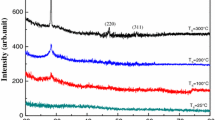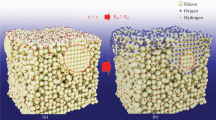Abstract
The transition from amorphous to crystalline silicon in films prepared in a hydrogen-diluted silane plasma has been studied. Emphasis was placed on the role played by hydrogen during film growth. Hydrogen is found to govern the film formation process by promoting the reverse process, ‘etching’. By preferentially eliminating energetically unfavorable configurations during the film growth, hydrogen controls the atomic structure, hydrogen incorporation, and grain growth of the film. It affects the total hydrogen content in the film, as well as the way hydrogen is bonded to the silicon. Excessive hydrogen dilution, however, reduces the grain size by changing the columnar grain growth to a more spherical-like grain growth, and eventually eliminates film growth. With appropriate hydrogen dilution, plasma deposition was found to yield ‘polycrystalline’ silicon films which has a large distribution of grain sizes, with the largest grains being about 2000 Å.
Similar content being viewed by others
References
For example, see M. J. Thompson, in Materials Issues in Amorphous-Semiconductor Technology, edited by D. Adler, Y. Hamakawa and A. Madan (Mater. Res. Soc. Proc. 70, Pittsburgh, PA 1986), p.613.
S. Usui and M. Kikuchi, J. Non-Cryst. Solids 34,1 (1979).
A. Matsuda, S. Yamasaki, K. Nakagawa, H. Okushi, K. Tanaka, S. lizima, M. Matsumara and H. Yamamoto, Japan J. Appl. Phys. 19, L305 (1980).
T. Hamasaki, H. Kurata, M. Hirose and Y. Osaka, Appl. Phys. Lett. 37, 1084 (1980).
W. E. Spear, G. Willeke, P. G. LeComber and A. G. Fitzgerald, J. Physique 42, C4, 257 (1981).
S. Vepřek, V. Maracěk: Solid State Electr. 11, 683 (1968).
C. C. Tsai, J. C. Knights, G. Chang and B. Wacker, J. Appl. Phys. 59, 2998 (1986).
C. C. Tsai, J. G. Shaw, B. Wacker and J. C. Knights, in Amorphous Silicon Semiconductors-Pure and Hydrogenated, edited by A. Madan, M. Thompson, D. Adler and Y. Hamakawa (Mater. Res. Soc. Proc. 95, Pittsburgh, PA 19867), p.219.
N. Shibata, K. Fukuda, H. Ohtoshi, J. Hanna, S. Oda and I. Shimizu, ibid., p.225.
G. Lucovsky and W. B. Pollard, in The Physics of Hydrogenated Silicon II, edited by J. D. Joannopoulos and G. Lucovsky (Springer-Verlag, New York, 1984) p. 333.
S. E. Ready, J. B. Boyce and C. C. Tsai, this proceeding.
Author information
Authors and Affiliations
Rights and permissions
About this article
Cite this article
Tsai, C.C., Thompson, R., Doland, C. et al. Transition from Amorphous to Crystalline Silicon: Effect of Hydrogen on Film Growth. MRS Online Proceedings Library 118, 49 (1988). https://doi.org/10.1557/PROC-118-49
Published:
DOI: https://doi.org/10.1557/PROC-118-49




